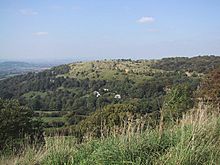Crickley Hill and Barrow Wake facts for kids
| Site of Special Scientific Interest | |

Looking from Barrow Wake to Crickley Hill
|
|
| Area of Search | Gloucestershire |
|---|---|
| Grid reference | & |
| Coordinates | 51°50′38″N 2°06′13″W / 51.843905°N 2.10374°W |
| Interest | Biological/Geological |
| Area | 56.8 hectare |
| Notification | 1974 |
Crickley Hill and Barrow Wake is a special place in Gloucestershire, England. It covers about 57 hectares of land. This area is so important for its nature and rocks that it was named a Site of Special Scientific Interest (SSSI) in 1974.
This amazing spot is found within the Cotswolds, which is a beautiful area known for its natural beauty. It used to be called just Crickley Hill, but it also includes a place called Tuffleys Quarry. Parts of Crickley Hill and Barrow Wake are looked after by Gloucestershire County Council and the National Trust. They manage it as a Country Park, which means it's a great place for people to visit and enjoy nature. The famous Cotswold Way walking trail even goes right through it!
Barrow Wake and Tuffley's Quarry are known as important wildlife areas. Crickley Hill is also recognized as a very important geological site, meaning it has special rocks and landforms.
Contents
What is Crickley Hill Like?
This site is located south of Cheltenham, on the edge of the Cotswolds hills. This area is called a "scarp" because it's a steep slope. Here, you can find many different natural habitats that are typical of the Cotswold limestone region.
These habitats include:
- Grasslands full of different plant species
- Natural woodlands
- Areas with bushes and shrubs
- Important rock formations that are special to the country
Amazing Plants and Animals
Crickley Hill is home to many types of grasslands. The grassy areas are filled with herbs that love lime-rich soil. You can find several kinds of beautiful orchids here, like the Early purple orchid, Bee Orchid, and Musk Orchid. Viper's Bugloss also grows in large numbers, showing off its bright blue flowers.
All these different plants help support a wide variety of small creatures. You might spot many different butterflies and moths, as well as local snails.
The site also has woodlands like Scrubbs and Crickley Woods. These are old Beech forests, with new Beech and Ash trees growing. Short Wood is another area with old Oak trees, like a park.
The sunny, steep slopes of the hill are perfect places for Adders (a type of snake) to warm themselves in the sun.
A Look at the Rocks
The rocks at Crickley Hill are very important for understanding the Earth's history. They show a major part of the Lower Inferior Oolite rock layer, which formed during the Jurassic period (the time of dinosaurs!).
You can see large sections of rocks from both the Lower and Middle Jurassic periods here. These rocks show the best examples in the Cotswolds of something called Pea Grit and the Coral Bed that lies on top of it.
Crickley Hill is part of the larger Cotswold escarpment, a long ridge of hills that stretches from Dorset all the way to the Yorkshire Coast. People have been quarrying (digging up) stone from this area for hundreds of years. The stone was probably used to build dry stone walls, which are common in the Cotswolds.
Ancient History and Discoveries
Imagine people living here over 5,000 years ago! There is strong evidence of ancient settlements at Crickley Hill. Because the soil on the hill is thin, the remains of these old settlements are found close to the surface, right under the grass.
Archaeologists, who are like history detectives, dug at this site every summer from 1969 to 1993. Their discoveries are considered very important around the world. They found signs that people lived here for over 4,000 years, from the Neolithic period (New Stone Age) all the way up to after the Roman period.
During their digs, the archaeologists often stayed at Ullenwood Camp, which is very close to Crickley Hill.
Crickley Hill Country Park: Explore and Learn
The Crickley Hill Country Park was created in 1979. It's a fantastic place to visit and enjoy the outdoors. Here, you can explore:
- Beautiful limestone grasslands
- Shady beech woodlands
- Peaceful oak parkland
- An ancient archaeological site
- Amazing panoramic views of the surrounding countryside
The park has several self-guided trails with maps and information leaflets to help you explore. Some of these trails include:
- The Hill Fort Trail
- The Scrubbs Trail
- The Scarp Trail
- The Family Trail
- The Park Trail
You can also find longer circular walks, measuring about 5 or 8.5 miles, if you want a bigger adventure.
Crickley Hill is looked after by wardens from Gloucestershire Country Council and volunteers from the Cotswold Warden Service. They help keep the park beautiful and safe for everyone.
Crickley Hill in Poetry
Crickley Hill was even written about in a poem by Ivor Gurney in 1919. In his poem, he described how remembering and talking about the hill helped soldiers bond on the Western Front during World War I. For them, the hill represented a small piece of England that they felt they were fighting for.
Images for kids


